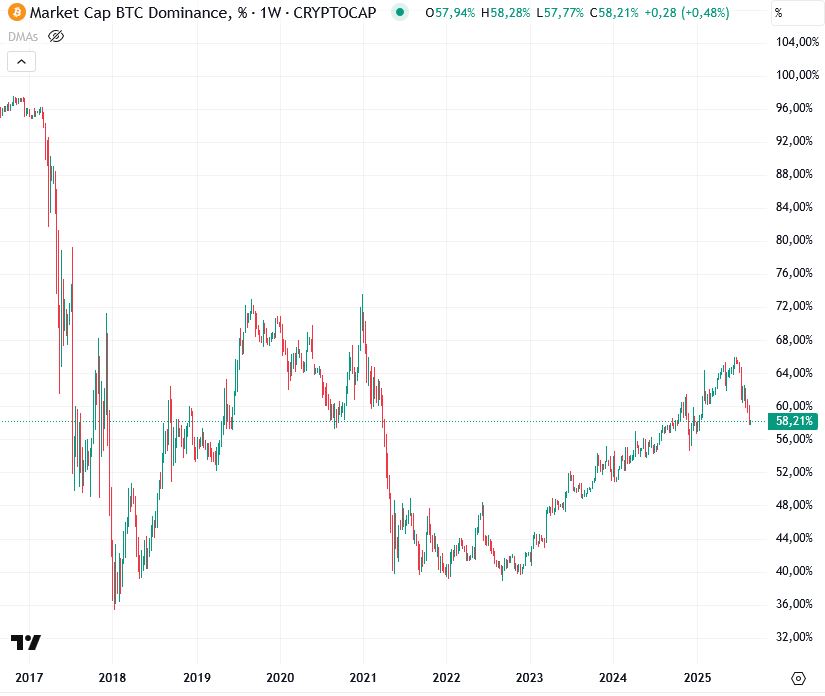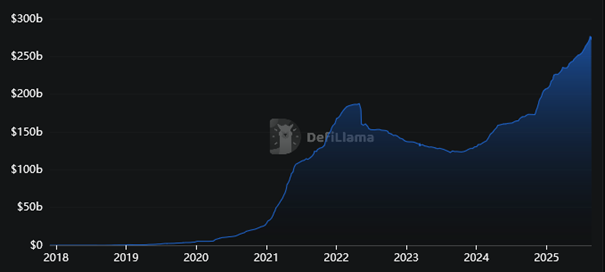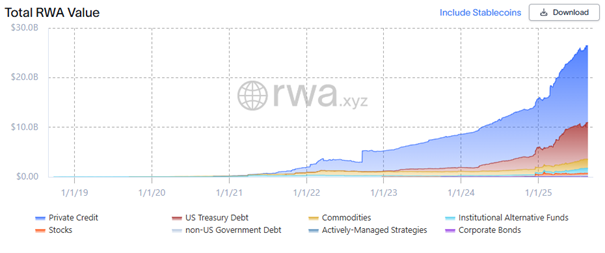On Friday, Fed Chair Jerome Powell opened the door to an interest rate cut in September during his speech in Jackson Hole, stating that "the shifting risk landscape could justify an adjustment to our policy." Investors are now wondering whether this marks the starting signal for Altcoin Season 2025.
US equities rallied strongly, bond yields dropped significantly, and Bitcoin - but especially Ethereum and other altcoins - clearly benefited from the prospect of looser financial conditions. Ethereum continued its impressive upward momentum, reaching its all-time high from November 2021 for the first time since then. This raises the question of whether this is the beginning of a new Altcoin Season - a phase in which cryptocurrencies outside of Bitcoin dominate the market and outperform on average.
Bitcoin Dominance and the Potential for an Altcoin Season
As always, it pays to take a broader perspective for a solid assessment. Since the launch of US Bitcoin ETFs, the market has been heavily shaped by Bitcoin’s presence. Digital gold was able to expand its market dominance from around 50 to over 65 percent. This rise now appears to be stalling - a classic setup for the beginning of an Altcoin Season. In previous bull markets, alternative coins temporarily reached up to 70 percent market share during such phases.

Fundamental Drivers of an Altcoin Season 2025
A sustainable bull market needs fundamental drivers. One of them is the continued devaluation of the dollar: to finance growing budget deficits, the US government is increasingly resorting to money creation. This environment strengthens classic stores of value such as Bitcoin or gold. With additional rate cuts expected, this trend is unlikely to weaken but rather accelerate.
Looking at the broader market, which by market capitalization essentially consists of smart contract blockchains and their application sectors such as DeFi as well as stablecoins, one thing is needed above all: widespread adoption of networks and their applications. This is where the US roadmap comes into play, clearly signaling its ambition to become the world’s number one crypto hub. The strategy paper adopted by the White House at the end of July lays out in unprecedented detail how the financial sector is expected to leverage efficient blockchain technologies within a secure legal framework.
Stablecoins as a Game Changer
A central aspect is the tokenized version of the dollar in the form of stablecoins. Their outstanding volume has reached a new all-time high of 230 billion US dollars, and major financial institutions have already announced plans to launch their own offerings. This makes the dollar accessible worldwide to anyone with an internet connection and a wallet - a true gamechanger for the future volume of stablecoins. Already in 2024, stablecoin settlement volumes in USD terms surpassed those of Visa and Eurocard. Settlements are processed via public blockchains such as Ethereum, Solana, or Tron - and it is precisely these networks that benefit directly, as is currently reflected in Ethereum’s surge.

Tokenized Real-World Assets as the Next Frontier
Tokenized real-world assets are also at an all-time high. Government bonds, private credit, and equities are increasingly being brought onto the blockchain, enabling not only more efficient settlement but also round-the-clock trading. Public blockchains are used here as well. A recent example is the launch of xStocks on Solana in June 2025: since then, more than 60 tokenized US stocks and ETFs have become available, including heavyweights such as Tesla, Apple, Microsoft, Amazon, and Nvidia. Alongside stablecoins, a second rapidly growing field of application is emerging: the tokenization of real assets. Stocks and ETFs are being made directly accessible worldwide via DeFi applications - including the option to use them as collateral for stablecoin loans. The market capitalization of these real-world assets (excluding stablecoins) currently stands at around 26 billion US dollars and, according to PwC estimates, could reach around 15 trillion US dollars by 2030.

Blockchain – The Underestimated $4 Trillion Technology
The signs for an Altcoin Season 2025 are therefore quite favorable. The fundamental use and demand for blockchains are further supported by the new legal certainty in the US, unlocking massive potential. Given the unmatched efficiency of blockchain-based settlement, it can be expected that an ever-greater share of assets will be processed directly via public blockchains in the future.
In addition, the still expansionary monetary policy with upcoming rate cuts creates a supportive environment for risk assets. The resurgence of Ethereum and the broader market is therefore no coincidence, and the chances of a broad-based rally by year-end look promising. Ultimately, the total market capitalization of blockchain technology amounts to around 4 trillion US dollars - still below the valuation of individual major tech companies.




